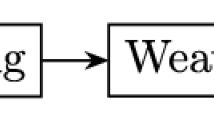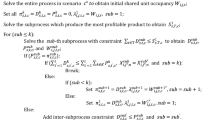Abstract
Presenting a more efficient mathematical model for the problem of integrating lot sizing, loading, and scheduling in capacitated flexible flow shops with sequence-dependent setups is the main novelty of this paper. In comparison to the former model, fewer variables and constraints of the current model makes it easier to be solved. Comparison between this model and the former one shows the superiority of this model. To validate the new model, an efficient lower bound has been provided. Mixed integer programming-based algorithms have been used to solve this model.
Similar content being viewed by others
References
Araujo S-A, Arenales M-N, Clark A-R (2007) Joint rolling-horizon scheduling of materials processing and lot-sizing with sequence-dependent setups. J Heuristics 13(4):337–358
Araujo S-A, Arenales M-N, Clark A-R (2008) Lot sizing and furnace scheduling in small foundries. Comput Oper Res 35(3):916–932
Beraldi P, Ghiani G, Grieco A, Guerriero E (2008) Rolling-horizon and fix-and-relax heuristics for the parallel machine lot-sizing and scheduling problem with sequence-dependent set-up costs. Comput Oper Res 35(11):3644–3656
Clark A-R (2003) Optimization approximations for capacity constrained material requirements planning. Int J Prod Econ 84(2):115–131
Clark A-R, Clark S-J (2000) Rolling-horizon lot-sizing when setup times are sequence-dependent. Int J Prod Res 38(10):2287–2308
Defersha F-M, Chen M (2008) A linear programming embedded genetic algorithm for an integrated cell formation and lot sizing considering product quality. Eur J Oper Res 187(1):46–69
Dillenberger C, Wollensak A, Zhang W (1992) On practical resource allocation for production planning and scheduling with different setup products. Draft paper, German Manufacturing Technology Centre, IBM. Sindelfigen, Germany
Eppen G-D, Martin R-K (1987) Solving multi-item capacitated lot-sizing problems using variable redefinition. Oper Res 35(6):832–848
Fandel G, Stammen-Hegene C (2006) Simultaneous lot sizing and scheduling for multi-product multi-level production. Int J Prod Econ 104(2):308–316
Fleischmannand B, Meyr H (1997) The general lotsizing and scheduling problem. Or Spekt 19(2):11–21
Jans R, Degraeve Z (2007) Meta-heuristics for dynamic lot sizing: a review and comparison of solution approaches. Eur J Oper Res 177(3):1851–1875
Kimms A (1993) Multi-level, single-machine lot sizing and scheduling (with initial inventory). Manuskripte aus den Instituten fűr Betriebswirtschaftslehre der Universität Kiel, No.329, Kiel
Kimms A (1996) Multi-level, single-machine lotsizing and scheduling (with initial inventory). Eur J Oper Res 89(1):86–99
Kimms A, Drexl A (1996) Some insights into proportional lotsizing and scheduling, Manuskripte aus den Instituten der universität Kiel, No.406, Kiel
Merece C, Fonton G (2003) Mip-based heuristics for capacitated lotsizing problems. Int J Prod Econ 85(1):97–111
Mohammadi M (2010) Integrating lotsizing, loading and scheduling decisions in flexible flow shops. Int J Adv Manuf Technol. doi:10.1007/s00170-010-2594-6
Mohammadi M, Fatemi Ghomi S-M-T, Karimi B, Torabi S-A (2010) Rolling-horizon and fix-and-relax heuristics for the multi-product multi-level capacitated lotsizing problem with sequence-dependent setups. J Intell Manuf 21(4):501–510
Mohammadi M, Fatemi Ghomi S-M-T, Karimi B, Torabi S-A (2010) MIP-based heuristics for lotsizing in capacitated pure flow shop with sequence-dependent setups. Int J Prod Res 48(10):2957–2973
Mohammadi M, Torabi S-A, Fatemi Ghomi S-M-T, Karimi B (2009) A new algorithmic approach for capacitated lot-sizing problem in flow shops with sequence-dependent setups. Int J Adv Manuf Technol. doi:10.1007/s00170-009-2366-3
Tempelmeier H, Buschkuhl L (2008) Dynamic multi-machine lotsizing and sequencing with simultaneous scheduling of a common setup resource. Int J Prod Econ 13(1):401–412
Wagner H-M, Whithin T-M (1958) Dynamic version of the economic lot size model. Manage Sci 5:89–96
Zhu X, Wilelm W-E (2006) Scheduling and lotsizing with sequence-dependent setups: a literature review. IIE Trans 38:987–1007
Author information
Authors and Affiliations
Corresponding author
Rights and permissions
About this article
Cite this article
Mohammadi, M., Jafari, N. A new mathematical model for integrating lot sizing, loading, and scheduling decisions in flexible flow shops. Int J Adv Manuf Technol 55, 709–721 (2011). https://doi.org/10.1007/s00170-010-3101-9
Received:
Accepted:
Published:
Issue Date:
DOI: https://doi.org/10.1007/s00170-010-3101-9




